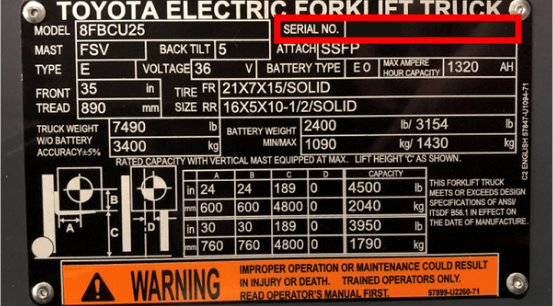How to Find Your Equipment Model Number.
Finding the right parts for your equipment is easy when you have your model and serial number which can be found on the data plate. Luckily, a forklift data plate is installed on every truck on the market to help you understand what your forklift can do and provide vital information.
Model Number: The model number of your toyota forklift is extremely important for relaying information to your dealers about repair or technical assistance and for looking up replacements part!
Serial Number: The serial number on your lift is the most important number.The model serial number combination will allow us to provide you with the parts that will fit your particular piece of equipment.

How to Find Your Equipment Serial Number
Finding the right parts for your equipment is easy when you have your model and serial number which can be found on the data plate. Luckily, a forklift data plate is installed on every truck on the market to help you understand what your forklift can do and provide vital information.
Model Number: The model number of your toyota forklift is extremely important for relaying information to your dealers about repair or technical assistance and for looking up replacements part!
Serial Number: The serial number on your lift is the most important number.The model serial number combination will allow us to provide you with the parts that will fit your particular piece of equipment.

Need some help? For further assistance or more information, contact your local Toyota Dealer.

Please click below to sign in to your MyToyota account
Don't have an account?
Facility Ventilation Practices for Safe Forklift Use

The use of LP, CNG, gasoline, and diesel forklifts can provide an increase in efficiency and higher ROI for many different types of operations. Whether moving material between manufacturing steps or increasing throughput in a warehouse, Toyota offers a wide variety of pneumatic tire and cushion tire internal combustion engine forklifts to fit your needs.
Facility design is one of the most important factors in protecting against the harms of exhaust, but a few key ventilation precautions can greatly reduce the risks from emissions.
But as with any piece of heavy machinery or equipment, proper precautions have to be taken to ensure people are protected from residual impacts of their use. In the case of LP, CNG, gasoline, and diesel forklifts, exhaust fumes can be harmful to employees and products if proper precautions aren’t taken. Facility design is one of the most important factors in protecting against the harms of exhaust, but a few key ventilation precautions can greatly reduce the risks from emissions. Here are a few reminders that you can use in your own facilities or bring to your supervisor’s attention.
Facility Ventilation Practices
Warehouses Need Proper Ventilation, Too
OSHA reported that most complaints of symptoms like dizziness and headache related to LPG forklift use came from warehouses. Performing a proper audit of your warehousing air flow can help to alleviate the possibility of harm from fumes to both people and products. If you run or work in a facility that requires both manufacturing and warehouse storage operation, then it’s important to remember to ventilate both areas.
Forklifts In Enclosed Areas Can Lead To Ventilation Problems
Many operators have to use forklifts in very tight areas, sometimes for long periods of time. Long exposure to fumes from an LP, gasoline, CNG, or diesel forklift can lead to the possibility of health hazards. When working in spaces like semi-trailers, within the confines of materials that can’t pass air (think cotton bails), or small rooms for storing specialty products, taking breaks is required. Understanding how to offer proper air flow to these areas by opening windows and vents and providing fans can help limit risks. And according to OSHA standards, operating forklifts onboard a ship requires special precautions to ensure the right levels of oxygen are present in tight spaces.
Weather Can Impact Your Ventilation
When things get cold outside, we tend to want to keep heat in. But when you close your windows, doors, or vents, you also have to account for the fumes that might fill your forklift-operating areas. Make sure staying warm doesn’t come at the expense of fume exposure.